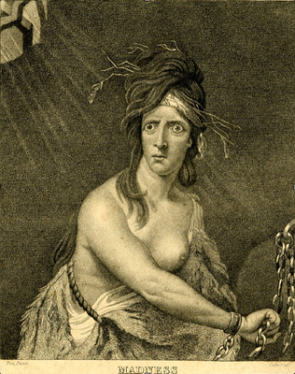
In Robert Edge Pine’s 1771 engraving Madness, the subject confronts the viewer with wide set, unfocussed eyes which are not fully aligned. Her hair is dishevelled by twigs and the chains used to restrain her portray her as an uncivilised subject. Her bare shoulder and exposed breast allude to the established discourse of the madness of possessed women as caused by ‘a sexualising physical abandon and a disregard for the apparel of civilised behaviour.’[1]
In France it has been suggested that the trope of the bare-breasted possessed woman did not enter the discourse of portraiture until the end of the nineteenth century.[2] Firstly, French reverence for the bare-breasted Marianne as the epitome of the revolutionary nation until 1871 played an important role in this national discursive difference between Britain and France.[3] Secondly, the lack of the overtly sexualised mad woman in French portraiture at the time might be considered reflective of the changing attitudes towards the mentally ill as well as reflecting a wider political discourse on the health of the French nation as a whole.
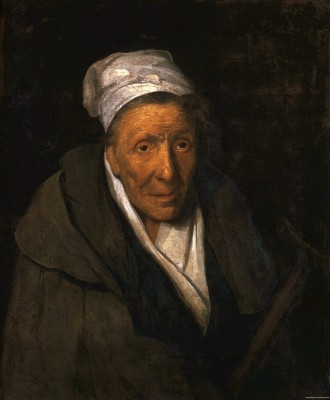
Théodore Géricault’s Portraits of the Insane illustrate this contrast vividly. For art historian Jane Kromm, the lack of explicitly disdainful connotations in Géricault’s work ‘reflects the romantic concern with interiority.’[4] Instead of projecting visible signs of insanity, Géricault’s subjects exude an unsettling quietness, the only clue to their particular mental illness revealed in the individual, and revealing, names of the pieces. The isolating use of earthy colours and positioning in the paintings still signal the subjects’ condemnation to the shadows of civilised society. However, Géricault favours a more realistic portrayal of mental illness, relying on facial detail and visible, slightly erratic brushmarks to convey the chaotic nature of the unstable mind. Believed to have been commissioned by his friend Étienne-Jean Georget, a psychiatrist who worked at the Salpêtrière hospital and later a private asylum in Ivry, studies have pointed to the similarities between Portraits of the Insane and illustrations in emerging psychiatric textbooks of the time; these claimed to use physiognomy as a means of diagnosing mental illnesses.[5]
As Georget wrote in 1820:
‘Generally, the face of idiots is silly and insignificant; that of maniacs, as agitated as their mind, is sometimes twitching and convulsed; the features of stupid people are downcast and expressionless; the cast of melancholics, contracted bears the imprint of pain or extreme absorption; the monomaniacal king has a proud and haughty air; the devout, humble or praying while fixed on heaven or the earth; the coward flees while looking off to the side, etc.’[6]
Géricault’s portraits illustrate, and therefore support, this belief in the congruence between mental health and outward appearance. The combination of the portraits’ titles with the visual imagery shapes the viewer’s response to the paintings.[7] As a result the portraits are framed within this particular scientific discourse which claimed that ‘true’ or ‘objective’ knowledge of a person’s inner mental dialogue, though ambiguous, could be interpreted and understood by trained physicians as based on ‘true’ or ‘objective’ facial features. Georget’s work gave the psychiatrist a key role in judicial cases by arguing for monomania as a qualifier for insanity defence.[8] In this manner, the hegemonic discourse of psychiatry asserted psychiatrists’ claim for greater influence in the increasingly scientific public sphere of knowledge by manufacturing illusions of truth presented as only decipherable by trained professionals.
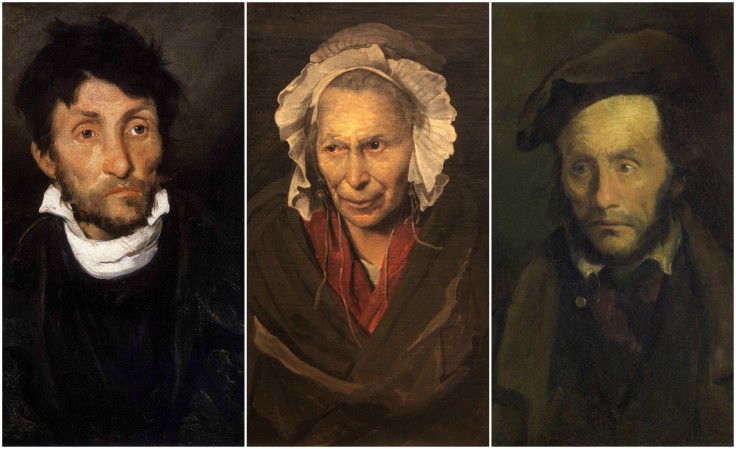
Indeed, in an 1822 inaugural lecture to students at the Salpêtrière, Georget’s mentor Jean-Étienne Esquirol claimed that the task of understanding mental illness ‘associates the physician with the public administration.’[9] Here the emerging discourse linking individual health to a larger question of national health is obvious; physicians such as Esquirol presented themselves as performing a pivotal role in the examination of individual mental health, and thus, by extension, the protection of national moral health. This had clear links with the religious discourse of the time; as one magazine article in 1830 stated:
‘A state without religion is like a human body without a soul, or rather like a human body of the species of the Frankenstein Monster, without a pure and vivifying principle.’[10]
Here the tendency to conceptualise the national political body as comparable to the individual body clearly emerges. Particularly poignant in light of the French political situation therefore is Géricault’s Le monomane du commandement militaire (seen below), supposedly depicting a man with obsessive delusions of military command.
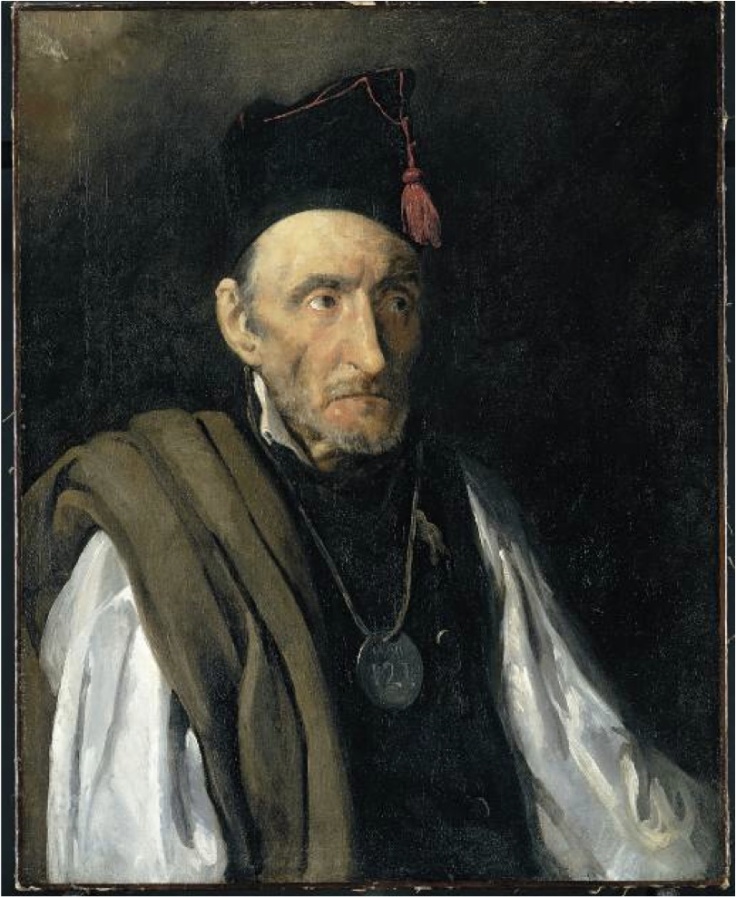
The subject is depicted wearing a military medal which, upon closer inspection, is dull and hangs from an improvised string; together with his conceited expression this alludes to his delusions. The man poses no obvious threat; instead, by framing this subject as suffering from a particular form of monomania linked to Bonapartism and the recent French experience of war, this portrait stands in dialogue with Restoration government fears about insurrection and national instability. Thus psychiatry and the institutionalisation of modern science are constructed as a necessary protective tool of the state, reflecting Géricault’s own materialist political faith in the power of national improvement through science.[11]
Géricault’s portraits reproduced the sight of the psychiatric institution and therefore embodied the particular sight of the ‘normal’ scientifically educated psychiatrists over the ‘abnormal’ asylum patients.[12] Portraits of the Insane therefore functioned as a reference point for the categorisation of normal and abnormal mental constitutions, contributing to the emerging psychiatric discourse which upheld specialised scientific knowledge as the authority and protector of national mental health. This discourse consisted of the psychiatric language of ‘monomania’, the visual imagery used to support it and the asylum as the institution of this knowledge which served to augment the power of psychiatry within society and politics.[13] Portraits of the Insane reflects the discourse of mental ‘abnormality’ as an inherently internal affliction, fully visible only to the professional eye of the psychiatrist, and therefore a threat to the political stability of a nation recovering from Bonaparte’s own monomane du commandement militaire.
Written by Samantha Sint Nicolaas.
[1] Jane Kromm, ‘”Marianne” and the Madwomen’, Art Journal 46, no. 4 (1987): p. 299.
[2] Ibid.
[3] Ibid.
[4] Ibid., p. 300.
[5] Ibid.
[6] Albert Boime, ‘Portraying Monomaniacs to Service the Alienist’s Monomania: Géricault and Georget’, Oxford Art Journal 14, no. 1 (1991): p. 87.
[7] On the relation between language and image in portraiture see: John Berger, Ways of Seeing (London: Penguin, 1973), p. 28.
[8] Boime, ‘Portraying Monomaniacs’, p. 88.
[9] Ibid., p. 86.
[10] Brendan Prendeville, ‘The Features of Insanity, as Seen by Géricault and by Büchner’, Oxford Art Journal 18, no. 1 (1995): p. 99.
[11] Boime, ‘Portraying Monomaniacs’, p. 87; Prendeville, ‘The Features of Insanity’, p. 100.
[12] For clarification of Foucault’s use of the term ‘discourse’ and the role of high art in discourse, see Lynda Nead, Myths of Sexuality. Representations of Women in Victorian Britain (Oxford: Basil Blackwell, 1988), pp. 4-8.
[13] See Berger, Ways of Seeing, p. 10.
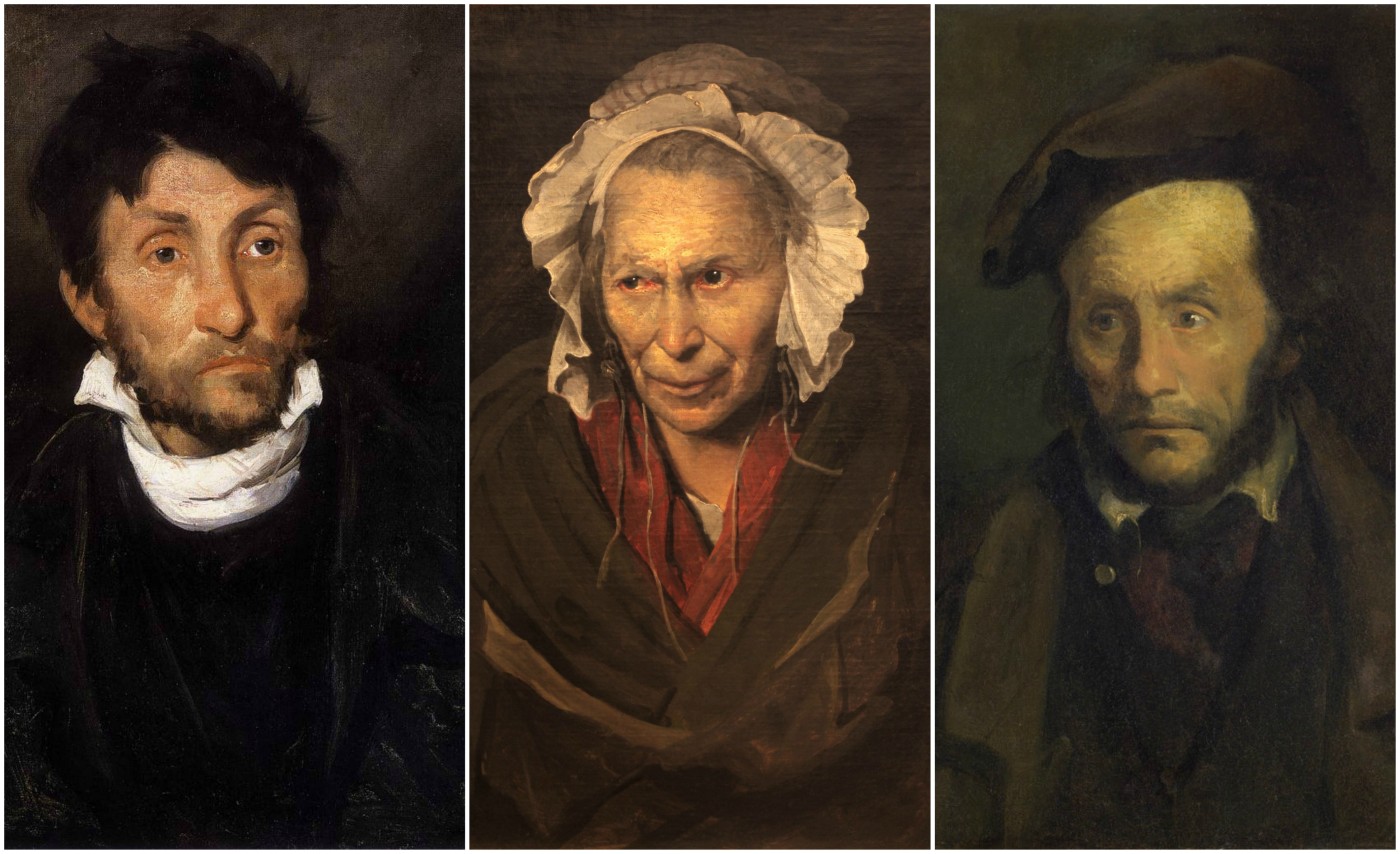
Leave a comment